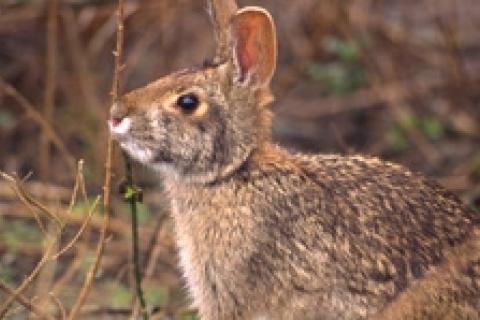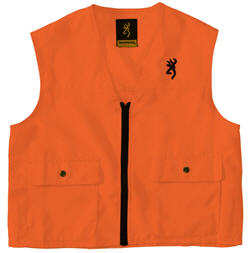
There's no doubt about it: chasing rabbits is fantastic sport. Hunting cottontails may lack the sudden explosiveness of quail hunting or the mesmerism of a green-timber mallard hunt at dawn, but it has an immeasurable allure all its own.
 If you carefully pick the coverts you visit, you can be fairly certain you'll bag at least a few rabbits, making each day a success. Thus, rabbit hunting is a great way to introduce youngsters and novices to hunting. Chances of gathering enough rabbits for several tasty meals are excellent as well. And whether you hunt with or without dogs, you'll find rabbits offer an exciting challenge.
If you carefully pick the coverts you visit, you can be fairly certain you'll bag at least a few rabbits, making each day a success. Thus, rabbit hunting is a great way to introduce youngsters and novices to hunting. Chances of gathering enough rabbits for several tasty meals are excellent as well. And whether you hunt with or without dogs, you'll find rabbits offer an exciting challenge.
Click for a fried rabbit recipe
Rabbit hunting isn't a complicated sport. It can be as simple as a quiet walk with the ol' single-shot and a pocketful of shells. Or it can be a precise outdoor ritual with packs of beagles, planning to decide who will hunt where and the specialized equipment many hunters take along. There are many ways to hunt rabbits and lots of habitat types where rabbits are found. Perhaps that's why rabbit hunting is so popular.
How to Find Rabbits

Some places, naturally, are better than others for rabbit hunting, and it's not hard to locate the hotspots. Cottontails usually are found in areas with good cover adjacent to their favorite foods -- grasses, clover, broadleaf weeds, soybeans, wheat, alfalfa, garden crops and the buds, twigs and bark of small saplings and bushes.
Look for cottontails around small fields bordered by woods, brush and briars; along drainages and fence rows where vegetation has grown up, in recently cleaned timber clear-cuts, in brush-piles on freshly cleared land sites, in densely covered power line and railroad right-of-ways and other places providing hideouts and nearby forage. Favorite cover includes blackberry patches, briars, honeysuckle, thick grass and weeds and even rolled hay bales, abandoned farm machinery, irrigation pipes and culverts.

One good way to scout for cottontails is driving rural roads at dawn or dusk, using a county road map to mark where you see rabbits. It's a simple matter to locate rabbits later, because they'll be in cover nearest to where you saw them. Most of these places are on private land, but many landowners allow hunting if asked politely.
Tip: All you'll need for rabbit hunting is a shotgun, shells, blaze orange hunt clothing for safety and maybe a game bag to carry the kill.
How to Gear Up for a Successful Rabbit Hunt

Good marksmen with excellent stalking skills can bag plenty of rabbits with a .22 rifle, a pistol or even a bow and arrow. But most hunters find a light, quick-handling shotgun most effective in overgrown, close-quarters rabbit habitat where snap shooting is common. A 20-gauge shotgun with an improved-cylinder choke is one of the best choices, but almost any shotgun, regardless of gauge, action or choke, is adequate to hunt rabbits. As far as shot sizes, 6s and 7-1/2s are both good choices for cottontails.
Briars and thorns can make hamburger meat out of unprotected skin, so it's wise to wear thick clothing when rabbit hunting. It's amazing how much a pair of vinyl-faced canvas field pants can bolster a hunter's courage and success. A durable canvas upland hunting coat with a game bag for carrying rabbits makes plowing through chest-high stuff easier, too, and a heavy pair of gloves will help protect the hands. Because brush is often so thick that hunting partners are tough to see, it's wise to wear highly-visible, blaze-orange vests like the RedHead Blaze Cap and Vest combo, blaze orange hats like the Cabela's Lightweight Meshback cap or stocking caps like the for added safety.
TIP: Watch video: The Effectiveness of Blaze Orange in a hunting situation
Hunting Rabbits & Bunnies With Beagles

exciting experience for young hunters
and veterans alike.
Some things go together so perfectly that when one of the elements is missing, the whole thing seems out of kilter. One such combination is rabbits and beagles. It's possible to hunt rabbits without dogs, but it's tough to hunt them as well.
Two things make the beagle/bunny coterie so appealing. First is the rabbit's instinctive habit of circling. Rabbits have a small area they call home, and they don't like to leave it. So when flushed from cover, ol' longlegs is likely to sprint away, leaving the dogs far behind, then slow down until it feels threatened again, when it once more easily outdistances the dogs. But somewhere out yonder, usually not more than a couple hundred yards, Br'er Rabbit begins turning back to the area where he initially hopped out.
The hunters follow the chase by listening to the baying of the dogs, and that's the second big thrill of this sport. The hullabaloo of a beagle pack hounding a rabbit on a frosty winter morning is the kind of music angels will play for hunters who make it to the Happy Hunting Grounds.
Before long, the beagle music starts back the hunter's way, and he climbs up on some high ground to watch and wait. With luck, he'll soon catch a glimpse of the quarry running, maybe hopping, depending on how far back the dogs are. When the time is right, the gun comes up and another tasty rabbit is added to the bag. Usually. Sometimes the music is so enthralling the hunter doesn't want it to end, and he stands there, cradling his gun, just taking in the magical sights and sounds.
TIP: Read: Rabbits and Beagles: Tips From an Expert Hunter
How to Use the Hunting Method: Walking Up Rabbits
Of course, not every rabbit hunter can afford the luxury of a pack of beagles. Walking up rabbits is the most basic hunting method.
Methods differ from hunter to hunter, but if there's a sure-fire way for the "walk-'em-up" hunter to get a rabbit to forsake its tight-sitting, hope-that-human-doesn't-see-me custom, it's using a similar plan. Like other well-camouflaged critters, the rabbit can't stand to be out waited. A pause in the hunter's motions makes it a nervous wreck.
Walking Up Rabbits Works This Way: Enter a good location and begin walking through it very slowly. Ten paces, then stop for about 30 seconds. Then repeat the process. The sound of the approach may flush some rabbits, but often as not, it's the silent period that does the trick. Apparently the rabbits think they've been spotted and decide to make a run for it.
When hunting with a partner, it's best to be about 50 feet apart, walking abreast. Move in staggered succession. One hunter moves up about 10 feet and waits; the other hunter walks 10 feet, waits, and so on, alternating until the cover is worked. Occasionally, turn around and view the area just walked. Rabbits that didn't fall for the freeze trick often will break cover when passed.
TIP: Steps to Prevent Rabbit Fever
Rabbit Shooting Tips
Learn to snap shoot. Rabbits in heavy cover seldom offer more than an instant in which to make your shot. There's no time to swing through your target. You have to locate the dashing rabbit, shoulder your gun and shoot all in one motion.
On the rare occasions when a rabbit bolts across open ground you'll do well to ponder your shot, but not very long. On pass shots, swing through the body and beyond the head, shooting just as the bead clears the rabbit's nose. When your target is running straight away from you, don't draw your bead on that cottony-white tail. Instead, swing through the rabbit, centering your shot just beyond the head. The result is a fast kill and undamaged meat.

It pays to be ready for a cottontail's fleet rush from cover. Rabbits are adept at making their move when you and your partners are chewing the fat and let your guard down. Don't prop your gun over a shoulder or cradle it in your arm. Keep your firearm in the ready position, with your trigger hand on the grip and your index finger on the trigger guard. You'll miss too many shots if you parade around like a soldier with your gun pointed at the sky.
The real magic of rabbit hunting is its simplicity. It takes some work for rabbits, but it's not as hard as for some other game animals. There's no need to build blinds or stands. It's not imperative to be out at daybreak, and fancy, high-dollar equipment isn't needed. Just find the rabbits, and the fun comes naturally.
How to Field Care and Cook Rabbits
Few wild game meats are as delectable and versatile as rabbit. The flesh is delicate, white and lean, with just a hint of gaminess. It can be cooked in every conceivable way, from simply fried, baked or roasted to stews, casseroles and pies. The taste is comparable to that of chicken, and recipes for the two are interchangeable.
Wear disposable rubber gloves when dressing rabbits to avoid the possibility of contracting tularemia or other diseases cottontails occasionally carry. Use a sharp knife like the Victorinox Rabbit Knife to skin and gut the rabbit, and remove the feet and head. To prepare the rabbit for cooking, cut the forelegs from the body at the shoulder, and then cut and remove the hind legs at the hip. Separate the rib section from the loin and you're done.
Here's a great fried rabbit recipe to try:
Fried Rabbit Recipe
- Rabbit, cut into serving pieces
- 1 hot pepper
- 4 slices of garlic cloves
- 1 cup of milk
- 2 slightly beaten eggs
- Flour
- 1/2 cut shortening
- Salt and pepper
Parboil rabbit in a pot with enough water to cover it. Add the hot pepper and garlic cloves.
When the rabbit is tender, remove from the heat and drain off the water. Combine milk and slightly beaten eggs in a shallow bowl. Dip the rabbit pieces in the egg mixture, dredge in plain flour seasoned with some salt and pepper, and fry the pieces until done to taste in shortening heated in a skillet. Serves 2.
Hunt Safely in the Right Shade of Blaze Orange
- 276518 views

